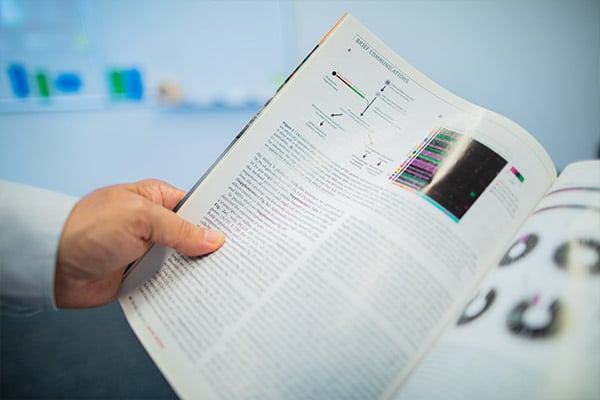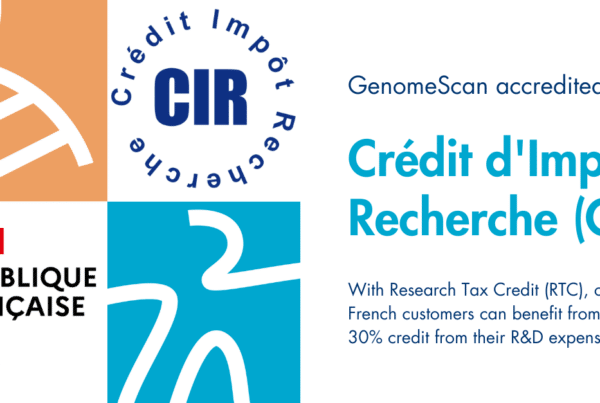At GenomeScan, we take pride in providing cutting-edge Next Generation Sequencing (NGS) services and high-quality data to researchers worldwide, and we couldn’t be more excited to see the incredible research work that has resulted from our collaboration. So, we want to celebrate these with an exciting opportunity to showcase research achievements of our scientific community.
Below articles are featured on our website as part of our publications campaign. If you would like to learn more about it, please visit this page.
For an overview of all featured scientific articles with GenomeScan’s contribution since 2012, please visit our publications page.
Selected Publications

Comprehensive diagnostics of acute myeloid leukemia by whole transcriptome RNA sequencing
- Published in Leukemia in 2021
- By dr. J. Hendrik Veelken
- With RNA sequencing (transcriptomics) services by GenomeScan
- Link to the article
Hendrik Veelken is Professor of Internal Medicine, specifically Haematology, and chair of the Department of Haematology in LUMC. In addition, he holds the function of coordinator of the LUMC Theme for Innovation “Cancer”.
In their study, Veelken and his colleagues sought to establish whole transcriptome RNA sequencing as a single, comprehensive, and flexible platform for acute myeloid leukemia (AML) diagnostics. In collaboration with GenomeScan, they performed whole transcriptome RNA sequencing on 100 AML cases. As a result, they accurately and simultaneously detected fusion genes, small genetic variants, and tandem insertions with diagnostic relevance for AML.

Transcriptional profiling of human microglia reveals grey–white matter heterogeneity and multiple sclerosis-associated changes
- Published in Nature Communications in 2019
- By Marlijn van der Poel
- With RNA sequencing (transcriptomics) services by GenomeScan
- Link to the article
Marlijn van der Poel was a PhD candidate in the Netherlands Institute for Neuroscience at the time of the publication, and currently holds a teaching position in University of Amsterdam.
In their study, van der Poel and her colleagues investigated the transcriptional profile of human microglia, isolated from normal-appearing grey matter (GM) and white matter (WM) of multiple sclerosis (MS) and non-neurological control donors, to find possible early changes related to MS pathology. As a result, they identified a region-specific transcriptional profile for human microglia in GM and WM tissue, especially important to consider in the search for novel therapeutic interventions. They also identified microglial changes in normal-appearing MS tissue associated with known MS pathology, pointing toward an important role for microglial metabolic changes in MS pathology.

Impacts of dietary exposure to pesticides on faecal microbiome metabolism in adult twins
- Published in Environmental Health in 2022
- By dr. Robin Mesnage
- With metagenome sequencing services by GenomeScan
- Link to the article
Robin Mesnage was a Research Associate in King’s College London at the time of the publication, and currently holds the position Lead Data Scientist in Buchinger Wilhelmi clinics in Germany.
In their study, Mesnage and his colleagues performed the first pesticide biomonitoring survey of the British population, and subsequently used the results to perform the first pesticide association study on gut microbiome composition and function from the TwinsUK registry. They selected 65 twin monozygotic twin pairs for their study and used shotgun metagenomics in collaboration with GenomeScan to analyze faecal microbiota. Their results provided the first evidence of an association between pesticide excretion and changes in gut microbiome metabolism at environmental levels of exposure in the UK population.

Gut colonisation by extended-spectrum β-lactamase-producing Escherichia coli and its association with the gut microbiome and metabolome in Dutch adults: a matched case-control study
- Published in Lancet Microbe in 2022
- By dr. Quinten Ducarmon
- With metagenome sequencing services by GenomeScan
- Link to the article
Quinten Ducarmon is a Postdoctoral Fellow, in LUMC at the time of the publication, and currently in EMBL Heidelberg.
Ducarmon and his colleagues performed the first study to investigate microbiome-mediated colonisation resistance against extended-spectrum β-lactamase (ESBL)-producing E coli using a combination of metagenomics, metabolomics, and machine-learning approaches. In collaboration with GenomeScan, they applied shotgun metagenomic sequencing to 51 ESBL-positive samples and 51 matched ESBL-negative samples. Their negative findings suggest that microbiome-mediated colonisation resistance might not be as relevant against ESBL-producing E coli as it is for other Gram-positive enteric pathogens.

Membrane adaptations and cellular responses of Sulfolobus acidocaldarius to the allylamine terbinafine
- Published in International Journal of Molecular Sciences in 2023
- By Alka Rao
- With RNA sequencing (transcriptomics) services by GenomeScan
- Link to the article
Alka Rao is a PhD candidate in University of Groningen in the field of biotechnology and applied microbiology.
In their study, Rao and her co-authors Niels A. W. de Kok and Arnold J. M. Driessen investigated the effect of terbinafine (an antifungal) on the lipidome and transcriptome of the aerobic crenarchaeon Sulfolobus Acidocaldarius. They were specifically interested in two membrane lipid types: bilayer-forming dialkyl glycerol diethers (DGDs) and monolayer-forming glycerol dialkyl glycerol tetraethers (GDGTs). Their transcriptomic data generated in collaboration with GenomeScan indicated that terbinafine has a multitude of effects, including significant differential expression of genes in the respiratory complex, motility, cell envelope, fatty acid metabolism, and GDGT cyclization.

SARS-coronavirus-2 replication in Vero E6 cells: replication kinetics, rapid adaptation and cytopathology
- Published in Journal of General Virology in 2020
- By Prof dr. Eric Snijder and co-authors
- With RNA sequencing (transcriptomics) services by GenomeScan
- Link to the article
Eric Snijder is professor of Molecular Virology and head of the Section Research of the Department of Medical Microbiology of Leiden University Medical Center (LUMC). He is also a board member of the LUMC Research Theme Infection and involved in a variety research projects on coronaviruses and antiviral drug development.
In their study, the LUMC team characterized the newly emerging SARS-CoV-2 and conducted a comparative analysis of the replication features of SARS-CoV-2 and SARS-CoV in Vero E6 cells, one of the most commonly used cell lines for studying these two viruses. By using NGS, they discovered the rapid evolution of the SARS-CoV-2 Spike protein when using Vero E6 cells. This later resulted in the discovery that the virus can use an alternative entry pathway in this cell line, which differs from the entry route used in human lung cells. This Vero E6 cell culture adaptation had important implications for the interpretation of drug screening data and many other SARS-CoV-2 studies performed in Vero E6 cells.
The authors also kindly added in the acknowledgements section: “We thank various GenomeScan staff members for the pleasant and swift collaboration that facilitated the NGS and data analysis of the first SARS-CoV-2 samples.”

Osteopontin associates with brain TRM-cell transcriptome and compartmentalization in donors with and without multiple sclerosis
- Published in iScience in 2023
- By dr. Cheng-Chih Hsiao
- With RNA sequencing (transcriptomics) services by GenomeScan
- Link to the article
Cheng-Chih Hsiao was a Senior Postdoctoral Fellow in the Netherlands Institute for Neuroscience at the time of the publication and currently holds Research Associate position in The Netherlands Brain Bank.
In their study, Hsiao and his colleagues compared gene expression profiles of tissue-resident memory T (TRM) cells from a total of 22 human brains post-mortem, either with multiple sclerosis (MS)-associated lesions or with normal-appearing white matter. Brain TRM cells showed a characteristic expression profile with presence of MS4A1 (CD20) and SPP1 (osteopontin, OPN) that was conserved in cells isolated from MS lesions. Notable, lesion-associated TRM cells produced less cytokines upon ex vivo, indicative of T-cell activity inhibition.

Microglia transcriptional profiling in major depressive disorder shows inhibition of cortical gray matter microglia
- Published in Biological Psychiatry in 2023
- By dr. Karel Scheepstra
- With RNA sequencing (transcriptomics) services by GenomeScan
- Link to the article
Karel Scheepstra is a psychiatrist and researcher at the Amsterdam UMC and Netherlands Institute for Neuroscience, whose work focuses on the neurobiology and treatment of mood disorders.
In their study, Scheepstra and his colleagues compared gene expression profiles of microglia isolated at brain autopsy from 13 donors with major depressive disorder (MDD) and 10 age-matched control donors. Their analysis on microglia isolated from occipital gray matter revealed 92 differentially expressed genes and indicated an immune-suppressed microglial phenotype in MDD. Microglia isolated from corpus callosum white matter did not show a significant difference between the groups.

A living biobank of patient-derived ductal carcinoma in situ mouse-intraductal xenografts identifies risk factors for invasive progression
- Published in Cancer Cell in 2023
- By Stefan Hutten
- With DNA sequencing (WES) services by GenomeScan
- Link to the article
Stefan Hutten is a PhD candidate in the Netherlands Cancer Institute (NKI), in the group of Jos Jonkers and as part of the PRECISION project.
In their study, Hutten and his colleagues developed and characterized 115 patient-derived mouse models of ductal carcinoma in situ (DCIS), which is a non-obligate precursor of invasive breast cancer. By employing a battery of omics and imaging analyses, they revealed multiple prognostic factors for high-risk DCIS including high grade, HER2 amplification, expansive 3D growth, and high burden of copy number aberrations. Their models were able to recapitulate the full heterogeneity of DCIS and may facilitate the development of more tailored treatment strategies for DCIS patients. Additionally, their work provided a collection of 19 models that can be distributed to other labs.

Molecular profile of MSH6-associated colorectal carcinomas shows distinct features from other Lynch syndrome–associated colorectal carcinomas
- Published in Gastroenterology in 2023
- By Noah Helderman
- With DNA sequencing (WES) services by GenomeScan
- Link to the article
Noah Helderman is a PhD candidate in the Leiden University Medical Center, Department of Clinical Genetics.
In their study, Helderman and his colleagues employed whole exome sequencing (WES) and cancer hotspot panel (CHP) methods to analyze 106 confirmed Lynch syndrome (LS) cases. Their findings indicated that in cases associated with MSH6 gene, which plays an essential role in repairing DNA, single nucleotide variations, rather than insertions or deletions, were driving the development of tumors. This suggests that MSH6-associated CRCs may be less sensitive to immunotherapies and frameshift peptide neoantigen-based vaccines compared with other LS subgroups.
The researchers also observed a lower abundance of CTNNB1 variants, which are believed to be responsible for an invasive growth pattern, in MSH6-associated cases in comparison to another LS subgroup. Their gene-based signature analysis also cast light on the potential time windows for mutational events in APC, KRAS, and TP53 gene variants in MSH6-associated CRCs.
More articles coming soon…
Above articles are featured on our website as part of our publications campaign. If you would like to learn more about it, please visit this page.
For an overview of all featured scientific articles with GenomeScan’s contribution since 2012, please visit our publications page.





